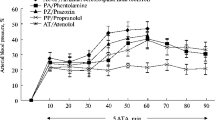Summary
The third ventricle and the aqueduct of the anaesthetized cat were cannulated and the hypothalamus was superfused with artificial cerebrospinal fluid. Electrical stimulation of the nucleus posterior of the hypothalamus elicited a rise of the blood pressure of 58±3 mm Hg (n=20). Superfusion of the hypothalamus with artificial cerebrospinal fluid containing bretylium (5×10−3 M) caused a gradual and long lasting impairment of the rise of blood pressure due to stimulation of the nucleus posterior. Tetracaine (1×10−3 M) diminished the rise of blood pressure to about the same extent as did 5×10−3M of bretylium; the inhibitory action of tetracaine was completely reversed within 120 min. Pretreatment of cats with 6-hydroxydopamine, which was applied through a Collison cannula implanted into the lateral ventricle, evoked a decrease of the noradrenaline content of the hypothalamus and of the rest of the brain and an impairment of the rise of blood pressure during stimulation of the nucleus posterior (33±3 mm Hg;n=6). The blood pressure of the anaesthetized cats was not affected by pretreatment with 6-hydroxydopamine. Superfusion of the hypothalamus with desipramine (1×10−4M) enhanced the rise of blood pressure elicited by electrical stimulation. The results are compatible with the assumption that the rise of blood pressure during stimulation of the nucleus posterior of the hypothalamus is mediated by adrenergic neurons of the brain.
Similar content being viewed by others
References
Boura, A. L. A., Copp, F. C., Duncombe, W. G., Green, A. F., MeCoubrey, A.: The selective accumulation of bretylium in sympathetic ganglia and their postganglionic nerves. Brit. J. Pharmacol.15, 265–270 (1960).
Carlsson, A., Waldeck, B.: Mechanism of amine transport in the cell membranes of the adrenergic nerves. Acta pharmacol. (Kbh.)22, 293–299 (1965).
Euler, U. S. v., Lishajko, F.: Improved technique for the fluorimetric estimation of catecholamines. Acta physiol. scand.51, 348–355 (1961).
Feldberg, W., Myers, R. D.: Appearance of 5-hydroxytryptamine and an unidentified pharmacological active lipid acid in effluent from perfused cerebral ventricles. J. Physiol. (Lond.)184, 837–855 (1966).
—, Sherwood, S. C.: A permanent cannula for intraventricular injections in cats. J. Physiol. (Lond.)120, 3–5P (1953).
Fuxe, K.: Evidence for the existence of monoamine neurons in the central nervous system. IV. Distribution of monoamine nerve terminals in the central nervous system. Acta physiol. scand.64, Suppl. 247 (1965).
Häusler, G., Haefely, W., Huerlimann, A.: On the mechanism of the adrenergic nerve blocking action of bretylium. Naunyn-Schmiedebergs Arch. Pharmak.265, 260–277 (1969).
Karplus, J. P., Kreidl, A.: Gehirn und Sympathicus. VII. Über Beziehungen der Hypothalamuszentren zu Blutdruck und innerer Sekretion. Pflügers Arch. ges. Physiol.215, 667–670 (1927).
Magoun, H. W.: Excitability of the hypothalamus after degeneration of corticifugal connections from the frontal lobes. Amer. J. Physiol.122, 530–532 (1938).
Merlis, J. K.: The effect of changes in the calcium content of cerebrospinal fluid on spinal reflex activity in the dog. Amer. J. Physiol.131, 67–72 (1940).
Morpurgo, C., Morillo, A.: The effect of bretylium on sympathetic responses elicited by hypothalamic stimulation. Life Sci.1, 263–269 (1962).
Palmer, J. F.: The use ofβ-thiopropionic acid for stabilizing the fluorescence of adrenaline and noradrenaline. J. Pharm. Pharmacol.15, 777–778 (1963).
Philippu, A., Becke, H., Burger, A.: Effect of drugs on the uptake of noradrenaline by isolated hypothalamic vesicles. Europ. J. Pharmacol.6, 96–101 (1969).
—, Heyd, G., Burger, A.: Release of noradrenaline from the hypothalamus in vivo. Europ. J. Pharmacol.9, 52–58 (1970).
—, Przuntek, H., Heyd, G., Burger, A.: Central effects of sympathomimetic amines on the blood pressure. Europ. J. Pharmacol.15, 200–208 (1971).
Reinoso-Suarez, F.: Topographischer Hirnatlas der Katze. Darmstadt: Merck AG 1961.
Thoenen, H., Tranzer, J. P.: Chemical sympathectomy by selective destruction of adrenergic nerve endings with 6-hydroxydopamine. Naunyn-Schmiedebergs Arch. Pharmak. exp. Path.261, 271–288 (1968).
Winne, D.: Zur Auswertung von Versuchsergebnissen: die Prüfung, ob Kurven sich in ihrem Verlauf unterscheiden. Naunyn-Schmiedebergs Arch. exp. Path. Pharmak.250, 383–396 (1965).
Author information
Authors and Affiliations
Additional information
This work was supported by the Deutsche Forschungsgemeinschaft.
Rights and permissions
About this article
Cite this article
Przuntek, H., Guimaraes, S. & Philippu, A. Importance of adrenergic neurons of the brain for the rise of blood pressure evoked by hypothalamic stimulation. Naunyn-Schmiedebergs Arch. Pharmak. 271, 311–319 (1971). https://doi.org/10.1007/BF00997225
Received:
Issue Date:
DOI: https://doi.org/10.1007/BF00997225



